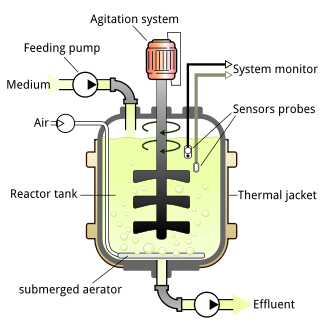Top Qs
Timeline
Chat
Perspective
Photofermentation
From Wikipedia, the free encyclopedia
Remove ads
Photofermentation is the fermentative conversion of organic substrate to biohydrogen manifested by a diverse group of photosynthetic bacteria by a series of biochemical reactions involving three steps similar to anaerobic conversion. Photofermentation differs from dark fermentation because it only proceeds in the presence of light.
For example, photo-fermentation with Rhodobacter sphaeroides SH2C (or many other purple non-sulfur bacteria[1]) can be employed to convert small molecular fatty acids into hydrogen[2] and other products.

Remove ads
Light-dependent pathways
Summarize
Perspective
Phototropic bacteria
Phototropic bacteria produce hydrogen gas via photofermentation, where the hydrogen is sourced from organic compounds.[4]
Photolytic producers
Photolytic producers are similar to phototrophs, but source hydrogen from water molecules that are broken down as the organism interacts with light.[4] Photolytic producers consist of algae and certain photosynthetic bacteria.[4]
(algae)[4]
(photolytic bacteria)[4]
Remove ads
Sustainable energy production
Summarize
Perspective
Photofermentation via purple nonsulfur producing bacteria has been explored as a method for the production of biofuel.[5] The natural fermentation product of these bacteria, hydrogen gas, can be harnessed as a natural gas energy source.[6][7] Photofermentation via algae instead of bacteria is used for bioethanol production, among other liquid fuel alternatives.[8]

Mechanism
The bacteria and their energy source are held in a bioreactor chamber that is impermeable to air and oxygen free.[7] The proper temperature for the bacterial species is maintained in the bioreactor.[7] The bacteria are sustained with a carbohydrate diet consisting of simple saccharide molecules.[9] The carbohydrates are typically sourced from agricultural or forestry waste.[9]
Variations

In addition to wild type forms of Rhodopseudomonas palustris, scientists have used genetically modified forms to produce hydrogen as well.[5] Other explorations include expanding the bioreactor system to hold a combination of bacteria, algae or cyanobacteria.[7][9] Ethanol production is performed by the algae Chlamydomonas reinhardtii, among other species, in cycling light and dark environments.[8] The cycling of light and dark environments has also been explored with bacteria for hydrogen production, increasing hydrogen yield.[10]
Advantages
The bacteria are typically fed with broken down agricultural waste or undesired crops, such as water lettuce or sugar beet molasses.[11][5] The high abundance of such waste ensures the stable food source for the bacteria and productively uses human-produced waste.[5] In comparison with dark fermentation, photofermentation produces more hydrogen per reaction and avoids the acidic end products of dark fermentation.[12]
Limitations
The primary limitations of photofermentation as a sustainable energy source stem from the precise requirements of maintaining the bacteria in the bioreactor.[7] Researchers have found it difficult to maintain a constant temperature for the bacteria within the bioreactor.[7] Furthermore, the growth media for the bacteria must be rotated and refreshed without introducing air to the bioreactor system, complicating the already expensive bioreactor set up.[7][9]
Remove ads
See also
References
External links
Wikiwand - on
Seamless Wikipedia browsing. On steroids.
Remove ads

![{\displaystyle {\mathrm {C} {\vphantom {A}}_{\smash[{t}]{6}}\mathrm {H} {\vphantom {A}}_{\smash[{t}]{12}}\mathrm {O} {\vphantom {A}}_{\smash[{t}]{6}}{}+{}6\,\mathrm {H} {\vphantom {A}}_{\smash[{t}]{2}}\mathrm {O} {}\mathrel {\xrightarrow {\text{hv}} } {}6\,\mathrm {CO} {\vphantom {A}}_{\smash[{t}]{2}}{}+{}12\,\mathrm {H} {\vphantom {A}}_{\smash[{t}]{2}}}}](http://wikimedia.org/api/rest_v1/media/math/render/svg/155c6018f7888b6a0c6f4bcc0cbd68ff2fd12e28)
![{\displaystyle {12\,\mathrm {H} {\vphantom {A}}_{\smash[{t}]{2}}\mathrm {O} {}\mathrel {\xrightarrow {\text{hv}} } {}12\,\mathrm {H} {\vphantom {A}}_{\smash[{t}]{2}}{}+{}6\,\mathrm {O} {\vphantom {A}}_{\smash[{t}]{2}}}}](http://wikimedia.org/api/rest_v1/media/math/render/svg/d7f3bcfdb157dc2a9dfedf1327c5638298ff61d2)
![{\displaystyle {\mathrm {CO} {}+{}\mathrm {H} {\vphantom {A}}_{\smash[{t}]{2}}\mathrm {O} {}\mathrel {\xrightarrow {\text{hv}} } {}\mathrm {H} {\vphantom {A}}_{\smash[{t}]{2}}{}+{}\mathrm {CO} {\vphantom {A}}_{\smash[{t}]{2}}}}](http://wikimedia.org/api/rest_v1/media/math/render/svg/ec354c12e9e6ba663c77e046cf056a277a45a2af)